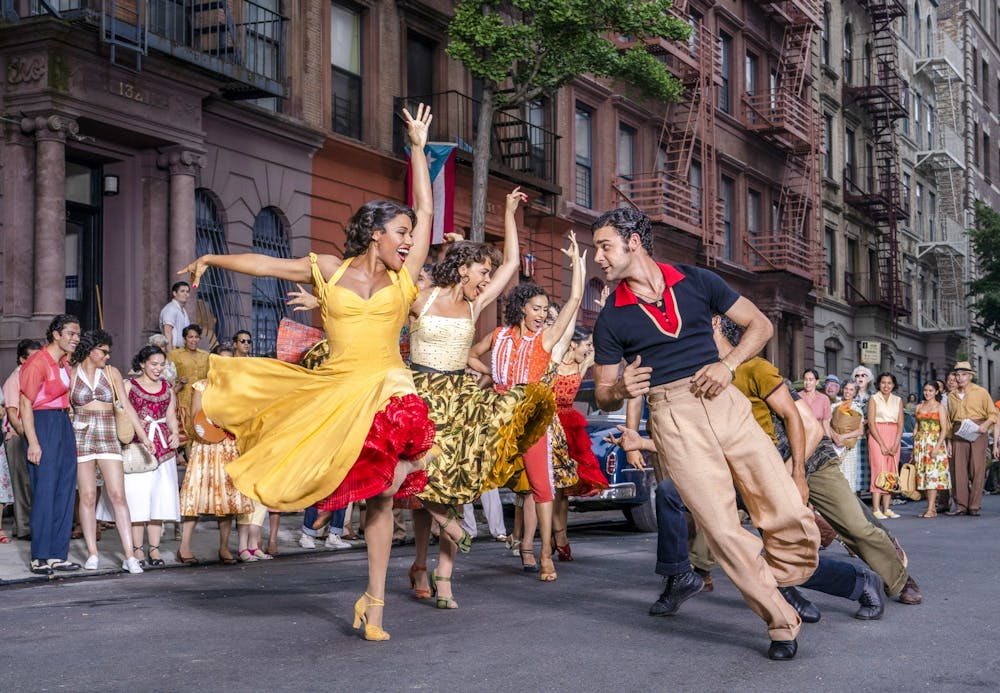Over six decades ago, four of the greatest minds in musical theater joined forces to stage an “experiment” that would become a living, breathing force transcending both stage and screen. 64 years after playwright Arthur Laurents, composer Leonard Bernstein, choreographer Jerome Robbins and lyricist Stephen Sondheim’s groundbreaking show made its debut on Broadway, West Side Story has retained its vitality — evolving with time while remaining faithful to the classic in Steven Spielberg’s reimagination.
Released Dec. 10, the Oscar-nominated film follows the star-crossed love of Tony (Ansel Elgort) and Maria (Rachel Zegler) amid a growing rivalry between the Jets — a gang of white delinquents — and the Sharks — their Puerto Rican counterparts. The film is set in a gentrified 1950s neighborhood in New York City’s Upper West Side and opens with a view of the destruction already in progress, with slums being destroyed for the development of new structures. This establishes the class-induced insecurity which catalyzes friction between the two gangs throughout the movie, and which operates intersectionally with the racist demeanor of the Jets and the economic struggles of the Sharks. The film’s iconic song “America” encapsulates this best: “Life is all right in America / If you’re all white in America.”
The film also highlights how linguistic barriers impede immigrants’ socioeconomic mobility and ability to assimilate. The Puerto Rican characters are most comfortable speaking – and singing – in Spanish, but counterintuitively feel the need to speak English even in domestic spaces, lapsing into unconscious code-switching. Spielberg also leaves Spanish interjections without subtitles, out of respect for the language and to avoid the portrayal of English as the dominant language.
These tensions are weaved into the film adeptly without making them the primary focus, and without drastically deviating from the original 1961 film — a fidelity that undoubtedly boosted the film’s success, especially among the many fans across generations that are bound by loyalty to the original.
But among the changes that they did make, the most significant and welcome was in casting. The 1961 film featured mostly white actors playing Latinx characters, including Natalie Wood as Maria. The only exception was Rita Monero — and her face was artificially darkened for the role. Spielberg’s version has a Latinx cast playing the Puerto Rican characters, including Zegler as Maria and David Alvarez as Bernado, her brother and leader of the Sharks. Zegler is the perfect Maria, starry-eyed but resolute, and Alvarez brings just the right amount of vivacity to Bernardo. But it is hard to deny that the rest of the cast is clearly overshadowed by Ariana DeBose, who steps into Moreno’s shoes to play Bernardo’s girlfriend Anita, captivating the attention of the audience every second she is on screen.
Monero, in addition to being an executive producer, was also a part of the cast — playing Valentina, the old woman who runs the drugstore where Tony works. Her appearance was the perfect nostalgic nod in a dynamic reimagination, and an accurate embodiment of the balance between faithfulness to the original work and evolution that Spielberg and screenwriter Tony Kushner have so strikingly maintained in every aspect of the film.
This balance seems all the more impressive in light of the sheer number of transformations “West Side Story” has gone through on its way to the screen this time around — from Shakespeare’s ‘Romeo and Juliet,’ which inspired the original Broadway musical, to the 1961 film, and finally to this transfiguration for the 21st-century audience. Through all the stages of its life cycle, “West Side Story” has retained its profundity, capturing emotional depth that stays the same through changing times.





